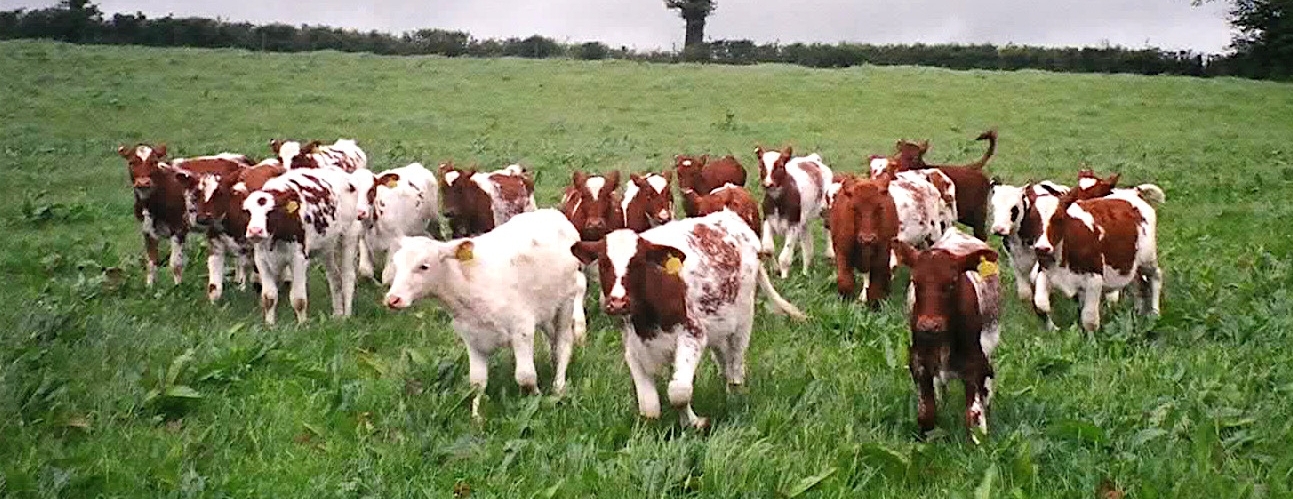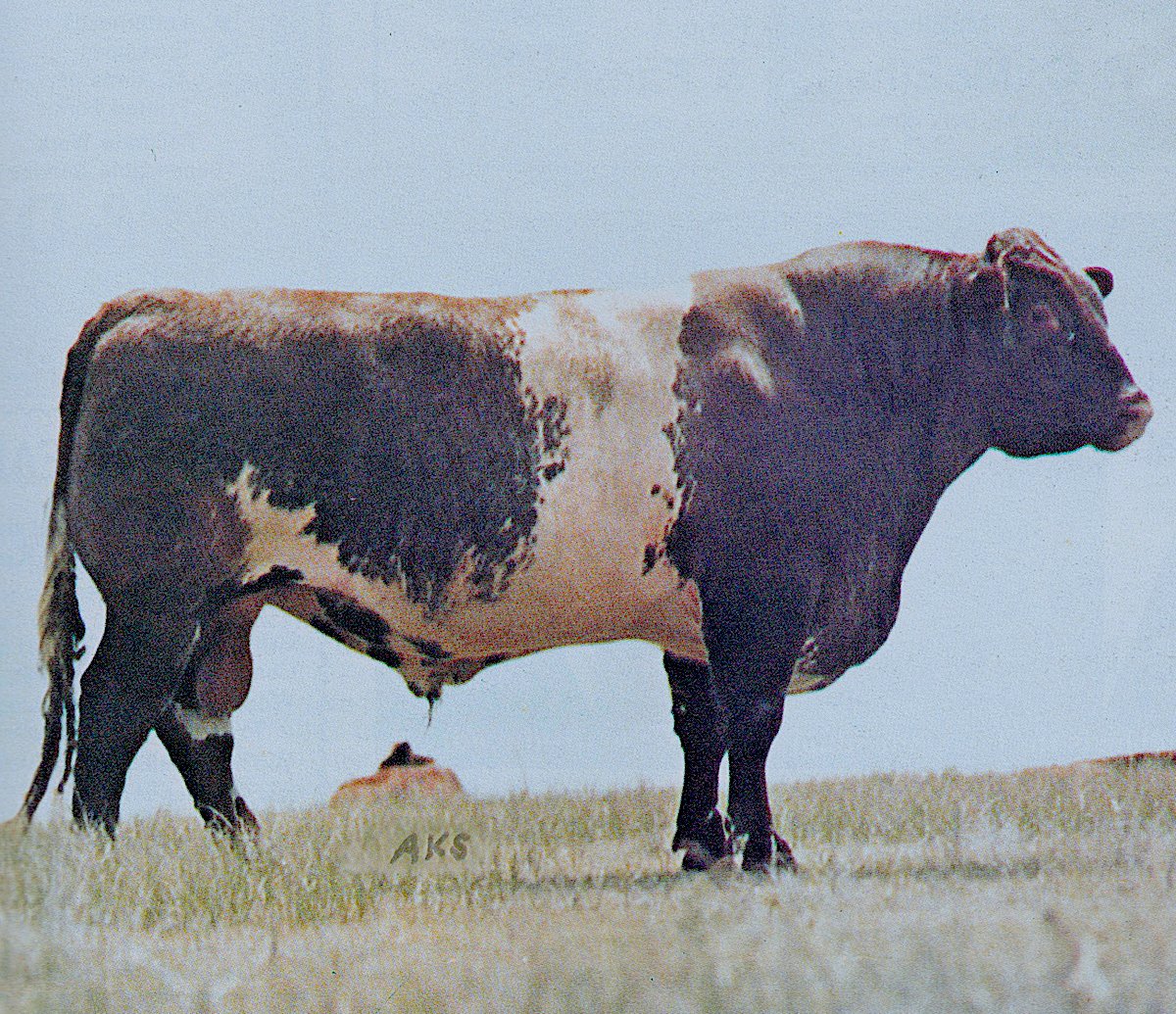Opportunities With Heritage Shorthorns
Marvelous opportunities exist for Heritage Shorthorns that can be seized on by anyone interested in pursuing a Heritage Shorthorn breeding program. Whether you are new to raising cattle, or have had cattle for many years and are looking for expanded marketing opportunities, Heritage Shorthorns provide many possibilities.
The many positive attributes of Heritage Shorthorns include: docility, feed efficiency, excellent milk production, ease of marbling in a pasture environment, longevity (they commonly live into their teens), and genetic purity (no integration of outside cattle breeds).
The list below is provided with no bias toward one application over another.
1. Grass fed beef
Heritage Shorthorns were bred for grass conversion and will “marble up” better than any other grass fed breed. It is totally realistic to attain well-marbled grass-fed steers ready for market at 18 months of age at a weight of 1000-1400#.
2. Heritage Shorthorn Certified Beef (HSCB)
Starting on June 1, 2021, HSS has a trademarked beef marketing program that highlights the benefits of Heritage and Heritage-influenced Shorthorn beef. The marketing website for HSCB is now active. For more information about how you can participate in this program, look at the HSCB page on this website just below the Heritage Breeders/Members Section.
Grass-fed Shorthorn Steaks
"The family cow all red and white, I love with all my heart. She gives me cream with all her might to eat with apple tart."
3. Family Cow
There is more and more demand for traditional family cows. The Shorthorn breed was originally developed in the late 1700’s to fill that very niche. There are many families today which want a cow that produces enough milk to sustain a family while still raising a calf that makes a good beef steer. The docility that pervades Heritage Shorthorns makes them a natural fit for this market.
4. Milking Shorthorns in small, grass-fed commercial dairies
More and more dairymen are looking at this as an option, especially in the New England area, because of the premium price of the milk produced, the increased health of the cows, and the dramatic decrease in dairy input costs. If this can be combined with organic status and homozygous A2 genetic status in the cows the “milk becomes almost priceless”. Some HS bloodlines have A2 genes. Milk produced from Heritage Dairy/Milking Shorthorns can be marketed under the specialty label—Heritage Shorthorn Milk.
5. Promote Heritage Livestock
The heritage livestock movement is a great way to honor the types of animals that were a traditional part of life in the history of the USA and Canada. Heritage Shorthorns are not only a heritage breed, they were the most widely used multi-purpose (beef, milk, working oxen) cattle breed for over 100 years.
6. Oxen for Draft Work
Most people are not aware that the covered wagons that travelled across the prairie in the middle of the 19th century were actually pulled mainly by Shorthorn oxen because of their strength, docility, and size. Recently oxen have come back into vogue in the heritage livestock movement, and quality Shorthorn oxen are in demand, especially horned Shorthorn steers.
7. Genetic Enhancement
There is demand for Heritage Shorthorn bloodlines to improve Modern Shorthorns—partly to reintroduce positive genetic traits to a mixed Shorthorn population but also to re-establish Shorthorn bloodlines that were lost in the “add new blood era”. Modern Shorthorns contain a percentage of other breeds as a result of the American Shorthorn Association and American Milking Shorthorn Society opening up their herd books to cross-bred animals. Heritage Shorthorns, by definition, do not have other breeds in their parentage; however they will add vigor when used on Modern Shorthorns and on other cattle breeds.
8. Heritage-Influenced Shorthorns
Using Heritage bloodlines on Modern Shorthorns produces a Heritage-Influenced Shorthorn which fits easily into a working beef or dairy operation while adding back desirable traits that may be missing in the Modern herd.
9. Show Steers & Heifers
Because of the docility of Heritage Shorthorns, their extremely diverse & beautiful color patterns, and their ability to grow they can make excellent 4-H and FFA market steers and show heifers.
10. Commercial Bulls
Hub’s Director
Because Heritage Shorthorns are really a “breed within a breed” they bring exceptional heterosis to any cross-breeding program and function very well as terminal sires. Their utilization in smaller/family grass fed beef operations is very beneficial because of their marbling ability and they are generally easier to work with compared to most other breeding bulls. As more Heritage Shorthorn artificial insemination bulls become available even the smallest breeder will have access to quality Heritage Shorthorn genetics.
11. Foundation Cows
No matter what type of Shorthorn breeding program a person wants to develop, a quality group of Heritage Shorthorn cows will give them flexibility to pursue that goal. Heritage Shorthorn foundation cows can be used to pursue multiple options simultaneously. As an example a breeder could combine milk production with the sale of quality grass fed steers, or produce beef cattle plus provide family cows.
Dairy/Milking Heritage Shorthorn
Beef type Heritage Shorthorn
12. Classic Horned Heritage Shorthorns
There are still breeders who prefer horned Heritage Shorthorns but horned Shorthorns are in limited supply because of the polled movement. This niche is definitely underserved, with horned Shorthorns being in demand especially to produce working oxen and/or for those people who just happen to like their very traditional, original appearance.
13. Small Shorthorns
Shorthorn Yearling Heifer, 1960s
Smaller size Shorthorns were popular in the 1950s and 1960s, and small cattle are again popular with some farmers. Some of the Heritage Shorthorn bloodlines from that time period carry dwarfing genetics for miniatures; however semen availability for this niche market is currently very limited.
14. Production of blue roan crosses
The purity of Heritage Shorthorns enhances the chance of producing blue roans for the show steer market especially if a white or light red roan Heritage Bull is used on an Angus cow or other black cow.
With all of the above options open to prospective Heritage Shorthorn breeders it is no wonder Heritage Shorthorns are rightfully regaining traction in the cattle industry. The Heritage Shorthorn Society intends to play an integral role in helping both current and prospective Heritage Shorthorns breeders take advantage of this resurgence in interest, both in the U.S. and in Canada.
Heritage Shorthorns are in a favorable position compared to other heritage breeds of cattle because of the tremendous genetic diversity & attributes that still exist due to the extensive number of Heritage Bulls that had semen collected on them in the 1950’s, 1960’s, and 1970’s. At that time Shorthorn popularity was extremely high and Shorthorns had not yet been openly crossed with other cattle breeds such as Maine Anjou, Red Angus, or Red & White Holsteins. This “semen reserve” has maintained a rich genetic diversity that can be used today to produce any type of Shorthorn. As an example, there is semen from Heritage bulls that weighed 1700# and bulls that weighed 3000#, bulls who’s daughter’s milk production reached 20,000# on a 305 day milk test period, and bulls that had carcass data/growth rates that are on a par with modern commercial Beef cattle.
It is important to note what sets Heritage Shorthorns apart from other heritage breeds and cattle breeds in general. The significance of Heritage Shorthorns can be measured in two ways. First they literally can be called the “mother of all breeds” because at least 38 other cattle breeds have used Shorthorn blood as part of their formation. Secondly, since the heritage lines can all be traced to the Coates herd book of 1822, their purity as a cattle breed is unparalleled. This is documented through what is called the “Lincoln Letter” research paper where the purity of Heritage Shorthorn DNA was compared to other cattle breeds and found to be much more tightly related.











